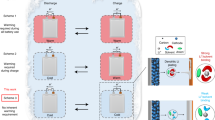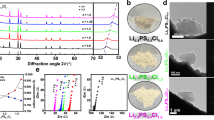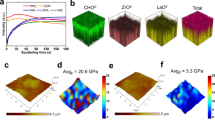Abstract
The lithium–sulfur battery is promising as an alternative to conventional lithium-ion technology due to the high energy density of both sulfur and lithium metal electrodes. An extended lifetime has been demonstrated, but two notable challenges still exist to realize its full potential: to overcome the undesired high electrolyte/sulfur ratio required for the catholyte-type mechanism that governs most cell configurations, and to inhibit Li dendrite growth and its parasitic reaction with the electrolyte that results in cell degradation. Here, we demonstrate that by tuning the electrolyte structure, the challenges at both electrodes can be tackled simultaneously. Specifically, the sulfur speciation pathway transforms from a dissolution–precipitation route to a quasi-solid state conversion in the presence of a lowered solvent activity and an extended electrolyte network, curtailing the need for high electrolyte volumes. Ab initio calculations reveal the nature of the network structure. With such an optimized structure, the electrolyte allows dendrite-free Li plating and shows a 20-fold reduction in parasitic reactions with Li, which avoids electrolyte consumption and greatly extends the life time of a low electrolyte/sulfur (5 µl mg–1) sulfur cell.
This is a preview of subscription content, access via your institution
Access options
Access Nature and 54 other Nature Portfolio journals
Get Nature+, our best-value online-access subscription
$29.99 / 30 days
cancel any time
Subscribe to this journal
Receive 12 digital issues and online access to articles
$119.00 per year
only $9.92 per issue
Buy this article
- Purchase on Springer Link
- Instant access to full article PDF
Prices may be subject to local taxes which are calculated during checkout






Similar content being viewed by others
References
Yin, Y. X., Xin, S., Guo, Y. G. & Wan, L. J. Lithium–sulfur batteries: electrochemistry, materials, and prospects. Angew. Chem. Int. Ed. 52, 13186–13200 (2013).
Yang, Y., Zheng, G. & Cui, Y. Nanostructured sulphur cathodes. Chem. Soc. Rev. 42, 3018–3032 (2013).
Fang, R. et al. More reliable lithium–sulfur batteries: status, solutions and prospects. Adv. Mater. 29, 1606823 (2017).
Manthiram, A., Chung, S. H. & Zu, C. Lithium–sulfur batteries: progress and prospects. Adv. Mater. 27, 1980–2006 (2015).
Peng, H.-J., Huang, J.-Q., Cheng, X.-B. & Zhang, Q. Review on high-loading and high-energy lithium–sulfur batteries. Adv. Energy Mater. 7, 1700260 (2017).
Ma, L., Hendrickson, K. E., Wei, S. & Archer, L. A. Nanomaterials: science and applications in the lithium–sulfur battery. Nano Today 10, 315–338 (2015).
Pang, Q., Liang, X., Kwok, C. Y. & Nazar, L. F. Advances in lithium–sulfur batteries based on multifunctional cathodes and electrolytes. Nat. Energy 1, 16132 (2016).
Ji, X., Lee, K. T. & Nazar, L. F. A highly ordered nanostructured carbon–sulphur cathode for lithium–sulphur batteries. Nat. Mater. 8, 500–506 (2009).
Xin, S. et al. Small sulfur molecules promise better lithium–sulfur batteries. J. Am. Chem. Soc. 134, 18510–18513 (2012).
Strubel, P. et al. ZnO hard templating for synthesis of hierarchical porous carbons with tailored porosity and high performance in a lithium–sulfur battery. Adv. Funct. Mater. 25, 287–297 (2015).
Ye, X., Ma, J., Hu, Y.-S., Wei, H. & Ye, F. MWCNT porous microspheres with an efficient 3D conductive network for high performance lithium–sulfur batteries. J. Mater. Chem. A 4, 775–780 (2016).
Zhou, G. et al. A graphene foam electrode with high sulfur loading for flexible and high energy Li–S batteries. Nano Energy 11, 356–365 (2015).
Song, J. et al. Nitrogen-doped mesoporous carbon promoted chemical adsorption of sulfur and fabrication of high-areal-capacity sulfur cathode with exceptional cycling stability for lithium–sulfur batteries. Adv. Funct. Mater. 24, 1243–1250 (2014).
Wei, S., Ma, L., Hendrickson, K. E., Tu, Z. & Archer, L. A. Metal–sulfur battery cathodes based on PAN–sulfur composites. J. Am. Chem. Soc. 137, 12143–12152 (2015).
Pang, Q., Kundu, D., Cuisinier, M. & Nazar, L. F. Surface-enhanced redox chemistry of polysulphides on a metallic and polar host for lithium–sulphur batteries. Nat. Commun. 5, 4759 (2014).
Zhang, Q. et al. Understanding the anchoring effect of two-dimensional layered materials for lithium–sulfur batteries. Nano Lett. 15, 3780–3786 (2015).
Peng, H.-J. et al. Enhanced electrochemical kinetics on conductive polar mediators for lithium–sulfur batteries. Angew. Chem. Int. Ed. 55, 12990–12995 (2016).
Rosenman, A. et al. Review on Li–sulfur battery systems: an integral perspective. Adv. Energy Mater. 5, 1500212 (2015).
Urbonaite, S., Poux, T. & Novak, P. Progress towards commercially viable Li–S battery cells. Adv. Energy Mater. 5, 1500118 (2015).
Eroglu, D., Zavadil, K. R. & Gallagher, K. G. Critical link between materials chemistry and cell-level design for high energy density and low cost lithium–sulfur transportation battery. J. Electrochem. Soc. 162, A982–A990 (2015).
Bonnick, P., Nagai, E. & Muldoon, J. Perspective—lithium–sulfur batteries. J. Electrochem. Soc. 165, A6005–A6007 (2018).
Cuisinier, M., Hart, C., Balasubramanian, M., Garsuch, A. & Nazar, L. F. Radical or not radical: revisiting lithium–sulfur electrochemistry in nonaqueous electrolytes. Adv. Energy Mater. 5, 1401801 (2015).
Pan, H. et al. On the way toward understanding solution chemistry of lithium polysulfides for high energy Li–S redox flow batteries. Adv. Energy Mater. 5, 1500113 (2015).
Han, F. et al. High-performance all-solid-state lithium–sulfur battery enabled by a mixed-conductive Li2S nanocomposite. Nano Lett. 16, 4521–4527 (2016).
Fu, K. K. et al. Three-dimensional bilayer garnet solid electrolyte based high energy density lithium metal–sulfur batteries. Energy Environ. Sci. 10, 1568–1575 (2017).
Wenzel, S. et al. Direct observation of the interfacial instability of the fast ionic conductor Li10GeP2S12 at the lithium metal anode. Chem. Mater. 28, 2400–2407 (2016).
Yu, C. et al. Accessing the bottleneck in all-solid state batteries, lithium-ion transport over the solid-electrolyte–electrode interface. Nat. Commun. 8, 1086 (2017).
Cuisinier, M. et al. Unique behaviour of nonsolvents for polysulfides in lithium–sulfur batteries. Energy Environ. Sci. 7, 2697–2705 (2014).
Cheng, L. et al. Sparingly solvating electrolytes for high energy density lithium–sulfur batteries. ACS Energy Lett. 1, 503–509 (2016).
Lee, C.-W. et al. Directing the lithium–sulfur reaction pathway via sparingly solvating electrolytes for high energy density batteries. ACS Cent. Sci. 3, 6056–613 (2017).
Yang, C. et al. Unique aqueous Li-ion/sulfur chemistry with high energy density and reversibility. Proc. Natl Acad. Sci. USA 24, 6197–6202 (2017).
Aurbach, D. & Gofer, Y. The correlation between surface chemistry, surface morphology, and cycling efficiency of lithium electrodes in a few polar aprotic systems. J. Electrochem. Soc. 136, 3198–3205 (1989).
Aurbach, D., Zinigrad, E., Cohen, Y. & Teller, H. A short review of failure mechanisms of lithium metal and lithiated graphite anodes in liquid electrolyte solutions. Solid State Ionics 148, 405–416 (2002).
Suo, L., Hu, Y.-S., Li, H., Armand, M. & Chen, L. A new class of solvent-in-salt electrolyte for high-energy rechargeable metallic lithium batteries. Nat. Commun. 4, 1481 (2013).
Qian, J. et al. High rate and stable cycling of lithium metal anode. Nat. Commun. 6, 6362 (2015).
Yoshida, K. et al. Oxidative-stability enhancement and charge transport mechanism in glyme−lithium salt equimolar complexes. J. Am. Chem. Soc. 133, 13121–13129 (2011).
Dokko, K. et al. Solvate ionic liquid electrolyte for Li–S batteries. J. Electrochem. Soc. 160, A1304–A1310 (2013).
Yamada, Y. et al. Unusual stability of acetonitrile-based superconcentrated electrolytes for fast-charging lithium-ion batteries. J. Am. Chem. Soc. 136, 5039–5046 (2014).
Wang, J. et al. Fire-extinguishing organic electrolytes for safe batteries. Nat. Energy 3, 22–29 (2018).
See, K. A. et al. Effect of hydrofluoroether cosolvent addition on Li solvation in acetonitrile-based solvate electrolytes and its influence on S reduction in a Li–S battery. ACS Appl. Mater. Interfaces 8, 34360–34371 (2016).
Wang, J. et al. Superconcentrated electrolytes for a high-voltage lithium-ion battery. Nat. Commun. 7, 12032 (2016).
Wujcik, K. H. et al. Characterization of polysulfide radicals present in an ether-based electrolyte of a lithium–sulfur battery during initial discharge using in situ X-ray absorption spectroscopy experiments and first-principles calculations. Adv. Energy Mater. 5, 1500285 (2014).
Wujcik, K. H., Wang, D. R., Pascal, T. A., Prendergast, D. & Balsara, N. P. In situ X-ray absorption spectroscopy studies of discharge reactions in a thick cathode of a lithium sulfur battery. J. Electrochem. Soc. 164, A18–A27 (2017).
Wood, K. N. et al. Dendrites and pits: untangling the complex behavior of lithium metal anodes through operando video microscopy. ACS Cent. Sci. 2, 790–801 (2016).
Bai, P., Li, J., Brushett, F. R. & Bazant, M. Z. Transition of lithium growth mechanisms in liquid electrolytes. Energy Environ. Sci. 9, 3221–3229 (2016).
Adams, B. D. et al. Long term stability of Li–S batteries using high concentration lithium nitrate electrolytes. Nano Energy 40, 607–617 (2017).
Aurbach, D., Weissman, I. & Schechter, A. X-ray photoelectron spectroscopy studies of lithium surfaces prepared in several important electrolyte solutions. A comparison with previous studies by Fourier transform infrared spectroscopy. Langmuir 12, 3991–4007 (1996).
Naoi, K., Mori, M., Naruoka, Y., Lamanna, W. & Atanasoski, R. The surface film formed on a lithium metal electrode in a new imide electrolyte, lithium bis(perfluoroethylsulfonylimide) [LiN(C2F5SO2)2]. J. Electrochem. Soc. 146, 462–469 (1999).
Strange, J. H., Rageb, S. M., Chadwick, A. V., Flak, K. W. & Harding, J. H. Conductivity and NMR study of ionic mobility in lithium oxide. J. Chem. Soc. Faraday Trans. 86, 1239–1241 (1990).
Zugmann, S. et al. Measurement of transference numbers for lithium ion electrolytes via four different methods, a comparative study. J. Electrochem. Soc. 155, A292–296 (2008).
Kresse, G. & Furthmüller, J. Efficient iterative schemes for ab initio total-energy calculations using a plane-wave basis set. Phys. Rev. B 54, 11169–11186 (1996).
Kresse, G. & Joubert, D. From ultrasoft pseudopotentials to the projector augmented-wave method. Phys. Rev. B 59, 1758–1775 (1999).
Perdew, J. P., Burke, K. & Ernzerhof, M. Generalized gradient approximation made simple. Phys. Rev. Lett. 77, 3865–3868 (1996).
Harl, J., Schimka, L. & Kresse, G. Assessing the quality of the random phase approximation for lattice constants and atomization energies of solids. Phys. Rev. B 81, 115126 (2010).
Hoover, W. G. Canonical dynamics: equilibrium phase-space distributions. Phys. Rev. A 31, 1695–1697 (1985).
Acknowledgements
This research was supported as part of the Joint Center for Energy Storage Research (JCESR), an Energy Innovation Hub funded by the US Department of Energy, Office of Science, Basic Energy Sciences. L.F.N. also thanks the NSERC for generous support via their Canada Research Chair and Discovery Grant programmes. We appreciate helpful discussions with T. Watkins and K. Zavadil.
Author information
Authors and Affiliations
Contributions
Q.P. and L.F.N. conceived the concept. Q.P. designed the experimental work. B.N. and Q.P. designed the computational work. Q.P. prepared the electrolytes and performed the physical characterization of the electrolytes and electrodes, electrochemistry measurements and the operando XRD studies. A.S. conducted the NMR experiments, and assisted with the electrolyte preparation, Raman studies and electrochemistry measurements. B.N. and L.A.C. carried out the computational work. C.Y.K. conducted the ionic conductivity measurements. Q.P, L.F.N. and L.A.C. proposed the sulfur reaction pathways. All authors have thoroughly discussed the analysis of the data. Q.P., B.N., L.A.C. and L.F.N. wrote the manuscripts with contributions from all authors. L.F.N. supervised the work.
Corresponding author
Ethics declarations
Competing interests
The authors declare no competing interests.
Additional information
Publisher’s note: Springer Nature remains neutral with regard to jurisdictional claims in published maps and institutional affiliations.
Supplementary information
Supplementary Information
Supplementary Tables 1–6, Supplementary Figures 1–20, Supplementary References
Rights and permissions
About this article
Cite this article
Pang, Q., Shyamsunder, A., Narayanan, B. et al. Tuning the electrolyte network structure to invoke quasi-solid state sulfur conversion and suppress lithium dendrite formation in Li–S batteries. Nat Energy 3, 783–791 (2018). https://doi.org/10.1038/s41560-018-0214-0
Received:
Accepted:
Published:
Issue Date:
DOI: https://doi.org/10.1038/s41560-018-0214-0
This article is cited by
-
Promoting polysulfide bidirectional conversion by one-dimensional p-n junctions for Li-S batteries
Science China Materials (2024)
-
A Review on Engineering Design for Enhancing Interfacial Contact in Solid-State Lithium–Sulfur Batteries
Nano-Micro Letters (2024)
-
Cage-confinement synthesis of MoC nanoclusers as efficient sulfiphilic and lithiophilic regulator for superior Li–S batteries
Rare Metals (2024)
-
Engineering Strategies for Suppressing the Shuttle Effect in Lithium–Sulfur Batteries
Nano-Micro Letters (2024)
-
Non-polar ether-based electrolyte solutions for stable high-voltage non-aqueous lithium metal batteries
Nature Communications (2023)



